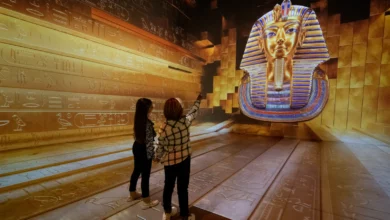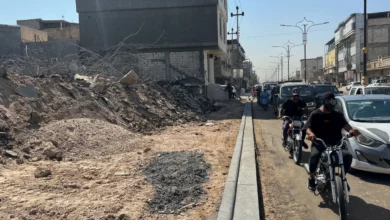1) Radwa Ashour's Specters, trans. Barbara Romaine
Radwa Ashour's half-memoir, half-novel Specters, published in 1999, is about many people, places and events–perhaps too many. But one of its central locations is Tahrir Square, and one of its central themes is revolt and its repression. Tahrir is important to Ashour both personally and politically: She spent much of her girlhood near the square, and notes that many Egyptian calls for freedom have been issued from there.
In February of 1946, she writes, there were massive demonstrations in Tahrir against the British, which were violently attacked by British authorities. Some 40,000 demonstrated against the occupying forces: 23 died, 122 were wounded.
Ashour learned of this uprising after a girlhood familiarity with Tahrir, and writes of how this knowledge changed her vision: “Places suddenly acquire a new meaning when you get to know their stories–maybe not the whole story but a glimpse of the story, a piece of it that suddenly illuminates the place, so that you see it in a way that you never saw it before or understood it.”
Ashour also describes student protests centered on Tahrir Square in January 1972, in which she participated with her husband, the poet Mourid Barghouti. She mentions that the 1975 workers' protests centered on Tahrir, as did the "bread riots" of 1977, which nearly unseated President Anwar Sadat.
2) Latifa al-Zayyat's The Open Door, trans. Marilyn Booth
Radwa Ashour's Specters also mentions the Tahrir of her friend Latifa al-Zayyat's The Open Door. Al-Zayyat's novel follows Layla, a young, middle-class Cairene whose growth mirrors the steps and missteps of the nascent Egyptian state. The book opens just after British forces crush the demonstrations of 21 February 1946 and continues through the early Nasser years. In its opening pages, the narrative listens in as people discuss how armored cars plowed through the protestors gathered in what was then Ismailiya Square.
One passerby remarks: "Don't forget we Egyptians are brave–a country of tough guys. The tank crushed the lad and right away the students raised his shirt high to show everyone; there was blood all over it. Then the crowd just went mad. They attacked the English tanks and pulled 'em apart, and then they started throwing their bodies right on the guns–why, you'd have thought they were made of sugar for all the people swarming around them."
Another man notes: "Then there's the way the workers joined the students. And everybody–all the Egyptian people."
3) Ibrahim Aslan's The Heron, trans. Elliott Colla
The Heron takes place at the beginning of the 1977 “bread riots.” The novel is written in Aslan's beautiful, simple style, and is well-rendered in English by translator Elliott Colla.
Tahrir also held a central place in the 1977 uprising. The narrator describes a scene in the square: "And Qasim who purchased five yards of white cloth and a bottle of blue ink and how he told you not to give a copy of the declaration of solidarity to every single person because there weren't enough copies to go around and that instead you were to give one copy to each group, and you telling him that you wanted to go with one of them and Qasim telling you everybody would go in pairs and you taking your share of the fliers and going with them to Tahrir Square where you saw the students who'd taken it over, and the foreigners who stood in front of the Izavitch Cafe and the cameras and movie advertisements on the huge billboards and the words that had been added to the marquees to change their meanings and scraps of paper everywhere and the ripped up cobblestones blocking the roads and you walking on with Fathi while he distributed his fliers and exchanged funny remarks with the crowds and you distributing your fliers but feeling embarrassed and out of place."
4) Mahmoud Wardani's Heads Ripe for Plucking, trans. Hala Halim
Wardani's novel, which relays six stories of decapitation, sets one of its most engaging portraits during the 1977 uprising. A good part of the action takes place in Tahrir, narrated by a Cairo teenager caught up in the riots, unsure of how he should position himself. He and his friends come across a boy who's chanting: "Parliament's all cronyism and spin / While people's freedom is reined in.”
The narrator continues: "Not only did we keep chanting back the slogan, we didn't put him down until there were only the three of us left. Everyone else was running toward Tahrir Square, though we hadn't seen a single soldier since the massacre in front of Sayyida Zaynab Police Station…. The clock on the Arab League building showed 2:00 p.m. The smell of tear gas was so overpowering I reckoned it meant there were soldiers lying in wait nearby."
Later, they decide: "We should just go home. This is bigger than we thought, it's a revolution. Where's it all going to take us?"
5) Sonallah Ibrahim's Zaat, trans. Anthony Calderbank.
No list of revolutionary literature, however short, would be complete without a hat tip to leading Egyptian novelist Sonallah Ibrahim, whose bravery in standing against the regime–particularly in his scathing 2003 refusal of the Arab Novel Award–is legendary.
Ibrahim’s Zaat offers a glimpse of Tahrir-based uprising, but also a sharp portrait of the corruption of Egypt's political and business classes.
Here, Sheikh El Arab tries to compete with television news to tell his story of Tahrir Square, circa 1946: "'In '46 I was working in a textile factory in Shubra. We went out on a big demonstration down to Bab El Hadid. The workers carried me on their shoulders. The demonstration lasted till Ismailia Square, Tahrir now. I used to have a picture of me shouting slogans, bullets flying through the air all around me, but State Security took it. I had a powerful voice and it rang through the square without a microphone. We were shouting for the struggle of the working class, the students, the Egyptian people, and the fall of Britain.'"




